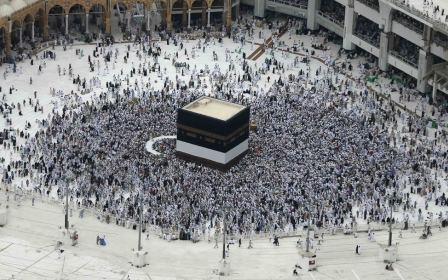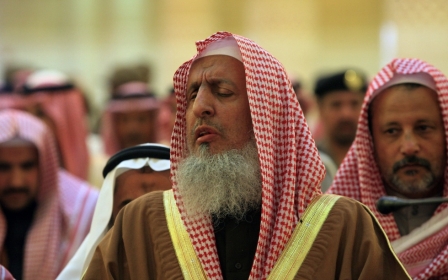Hajj reaches climax as Muslims climb Mount Arafat

The annual hajj pilgrimage reached its climax on Sunday when Muslims from across the world climbed a historic hill near the holy city of Mecca to pray and recite from the Qur'an.
More than 1.8 million gathered from sunrise at the hill and a vast surrounding plain known as Mount Arafat, about 15 kilometres from Mecca, where the Prophet Mohammed is believed to have given his final sermon.
A photo shows pilgrims climbing Mount Arafat, with a prayer in the text (from a pilgrim's Twitter account: @safeer_111)
Against a backdrop of distant, higher peaks, they squatted, stood, or climbed steps built into the hill while reciting their prayers.
From a distance, the hill appeared a snowy white, as male pilgrims wear a seamless two-piece white garment, called ihram.
It symbolises a state of purity and emphasises their unity regardless of social status or nationality.
White figures shroud Mount Arafat, with the text celebrating the "great day" (from a pilgrim's Twitter account: @safeer_111)
Women wear a loose dress, typically also white, but some like Soumaya, 30, of Mali wore traditional attire, in her case an orange robe.
"We feel at ease and are totally benefiting from our pilgrimage," she told AFP, giving only one name.
"Everything is very well organised," added her friend, Khadija Bechir, 23.
Pilgrims come from every corner of the globe, but Indonesia - the most populous Muslim nation - has the largest quota.
Official figures issued late Saturday said the total number of pilgrims exceeded 1.8 million, with more than 1.3 million arrived from outside Saudi Arabia.
New MEE newsletter: Jerusalem Dispatch
Sign up to get the latest insights and analysis on Israel-Palestine, alongside Turkey Unpacked and other MEE newsletters
Middle East Eye delivers independent and unrivalled coverage and analysis of the Middle East, North Africa and beyond. To learn more about republishing this content and the associated fees, please fill out this form. More about MEE can be found here.




